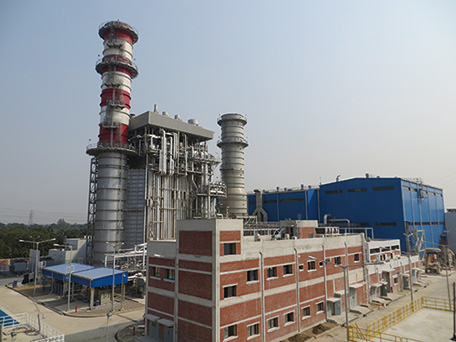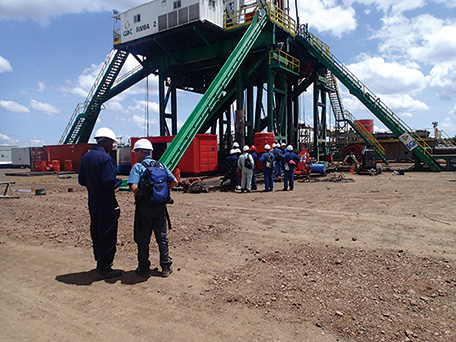(4) Resources and Energy (Including Renewable Energy)
The number of people who have no access to electricity in the world is estimated at around 1.3 billion (equivalent to 18% of the world's population). In particular, this number is estimated to reach two-thirds of the population (approximately 620 million people) in Sub-Saharan Africa. Meanwhile, in Sub-Saharan Africa, nearly four-fifths of the population (approximately 730 million people) rely on wood fuel (e.g., charcoal, firewood), which causes indoor air pollution during cooking and is a leading cause of death among young people.(Note 15) The lack of electricity, gas and other energy services leads to the delay in industrial development, a loss of employment opportunities, a further increase in poverty, and restricted access to medical services and education. Going forward, global energy demand is expected to increase further, mainly in Asian countries as well as other emerging and developing countries. Thus, a consistent energy supply and appropriate consideration to the environment are essential.
< Japan's Efforts >
In order to realize sustainable development and secure energy in developing countries, Japan works on the provision of services, which enables modern energy supply, and the stable supply of power for industrial development. In addition, Japan provides support for the establishment of an environmentally-friendly infrastructure, such as construction of energy-saving equipment and power generation facilities that utilize renewable energy (hydropower, solar power, wind power, geothermal power, etc.).
Meanwhile, Japan provides resource-rich countries with support according to their needs, such as establishing infrastructure in the areas around mines, aiming to enable them to acquire foreign currency through the development of their resources and to develop in a self-sustained way. Through these supports, Japan will enhance mutually beneficial relationships with developing countries with rich resources, while striving to ensure the stable supply of energy and mineral resources, by promoting the development of resources, production, and transportation by private companies. It is important to proactively use Japanese ODA in the resource and energy sectors alongside support from the Japan Bank for International Cooperation (JBIC), Nippon Export and Investment Insurance (NEXI) and Japan Oil, Gas and Metals National Corporation (JOGMEC).
Japan also proactively supports the Extractive Industries Transparency Initiative (EITI). EITI is a multinational cooperative framework created for increasing the transparency of the flow of money in development of oil, gas, mineral and other resources. Under this framework, extracting corporations report the amount of payment to the governments of resource-producing countries and the governments report the amount of received money. Participants in EITI include 39 resource-producing countries, many supporting countries including Japan, extractive companies and NGOs. EITI participants are working together to prevent corruption and conflict, as well as to encourage responsible resource development that leads to growth and poverty reduction.
- Note 15: Source: “World Energy Outlook 2013” (estimates as of 2011) (International Energy Agency [IEA]), “Africa Energy Outlook (2014)” (IEA)
| Bangladesh
New Haripur Power Plant Development Project (II)
Loan aid (March 2009 – Ongoing)

The view of the Haripur Power Plant in Bangladesh. (Photo: JICA)
In March 2014, the New Haripur Power Plant started operating in the Narayanganj District on the outskirts of Dhaka, the capital city of Bangladesh. This power station achieves both high heat efficiency and reduction of CO2 emission.
In Bangladesh, due to the recent increase of the electrification rate and the progress of industrialization, power supply is not keeping up with the demand. In 2014, the largest amount of power supplied was 7,536 megawatt (MW), while the potential demand was 9,652 MW; thus, power supply capacity remains around 80% of the demand. In addition, it is estimated that the demand for electricity will increase approximately 10% per year for the next 10 years.
The power generation capacity of the New Haripur Power Plant is 412 MW, one of the largest for a single thermal power station in the country. It is a combined-cycle power plant that uses natural gas and steam, and Japanese technologies are fully utilized for the important equipment of the plant: for example, the gas turbine was provided by Mitsubishi Heavy Industries, Ltd., and the steam turbines by Fuji Electric Co., Ltd. This state-of-the-art power plant has the heat efficiency of approximately 56%, more than twice that of other conventional gas thermal power plants in Bangladesh. In addition, the fact that it took virtually 36 months from the construction to the start of operation drew attention, since public projects tend to be delayed in the country.
Furthermore, “Long Terms Service Agreement” will be signed with a Japanese manufacturer in terms of the maintenance and operation of the gas turbine, in order to enhance the sustainability of the project. Specifically, in addition to the stable supply of hard-to-find parts produced by gas turbine manufacturers, personnel at the power plant will be given guidance on the operation and maintenance of the plant through periodic inspections of the gas turbine that will be conducted in a cycle of five or six years. This will provide a structure in which the local personnel at the power plant can carry out the long-term, stable operation and maintenance of the state-of-the-art power plant.
(As of August 2014)
| Kenya
The Project for Capacity Strengthening for Geothermal Development in Kenya
Technical Cooperation Project (September 2013 – Ongoing)

Instructions on drilling are provided at a geothermal development site in Kenya. (Photo: JICA)
In accordance with the economic growth and population increase, the peak demand of electricity in Kenya is expected to significantly increase to 12,738 – 22,985 megawatt (MW) by 2030, from 1,227 MW in 2010. However, as of 2011 the capacity of power generation facility is only 1,593 MW, and therefore, a large-scale development of power supply system will be required.
Taking notice of geothermal resources, which are said to have a potential generation capacity of 7,000 MW, the Government of Kenya split the geothermal department of Kenya Electricity Generating Company Limited (KenGen) to establish a new company, Geothermal Development Company Ltd. (GDC), in 2009. The Government of Kenya has also been planning to increase the capacity of power generation facility that uses geothermal energy to 5,300 MW.
Under this plan, GDC has been implementing operations including boring tests; however, the company faced technical challenges, such as the difficulty in identifying appropriate drilling points, in reaching the intended target, and in determined sustainable steam production amounts. Furthermore, technological improvements are required in exploration, boring, and assessment of geothermal reservoir. To address these challenges the Japanese government initiated the Project for Capacity Strengthening for Geothermal Development in Kenya, in which it dispatches experts and conducts month-long training programs in Japan to train about 22 people per year by teaching boring techniques and know-hows to assess reservoir. Japan also provides equipment to back up GDC's geothermal development initiatives, aiming to make contributions to the capacity building of around 500 personnel of GDC in a total of four years of the cooperation period.
(As of August 2014)
